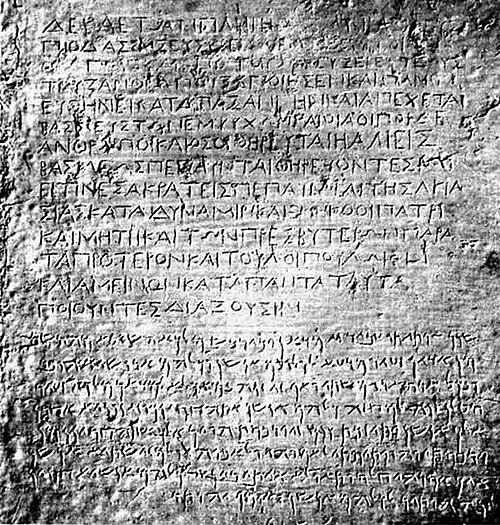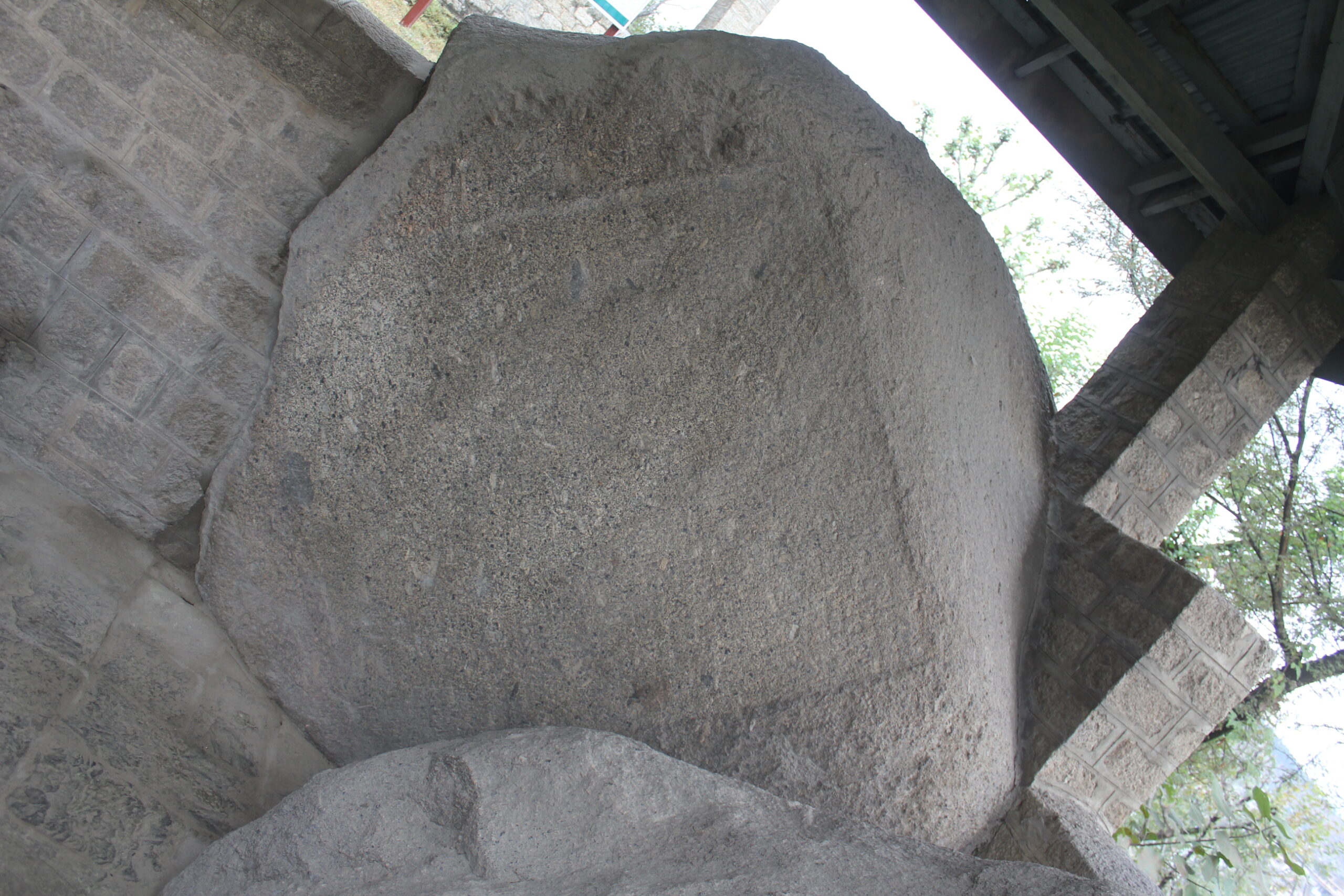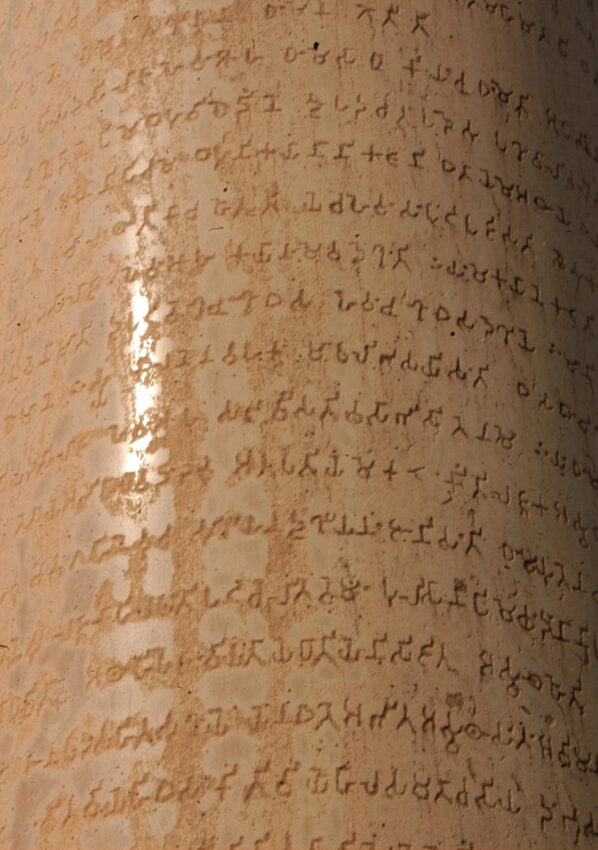Ashokan inscription constitution most important source of information about emperor Ashoka. The information provided by the Ashokan inscription also helped in a big way in the reconstruction of Mauryan history. Inscriptions of king Ashoka contain the Rock Edicts, pillar edicts & the cave inscription. These inscriptions have been found from all over the Indian subcontinent. These inscriptions provide information about the language & script of the age.
The language used for Ashokan Inscription
Prakrit is a common language in the Ashokan inscription. Brahmi is the most common script used in Ashokan Inscription. In some inscription Greek, Aramaic & Kharoshti having used. The use of Aramaic, Greek, Kharoshti script indicates that some foreigners were living in most North-Western regions of the empire.

Ashokan inscription also contains dates of various activities. According to the sixth pillar edict, Ashoka begins to issue major Rock Edict in his 13th regional year. According to the 13th major Rock Edict of Ashoka, the Kalinga war was fought in his 9th year of his region. The full name of emperor Ashoka is found only in an inscription.
Only the minor Rock Edict found at Gurjara Maski, Netter, Udegalon contain the full name of Ashoka as Ashoka Devanampiya Piyadasi. Before the decipherment of Ashokan Inscription. It was believed that king Devanampiya mentioned in “Ceylonese chronicles (Deepvamsha & Mahavamsha – two Buddhist Sri Lankan books) was a Sri Lankan king.
The geographical location of Ashokan Inscription helps in the determination of the territorial extent of the Mauryan Empire. Ashokan Inscription provides valuable information about, Nature and character of state under Ashoka; Names of officers & their fun; Personal history of Ashoka; Welfare measures are undertaken by Ashoka; Foreign relations were maintained by Ashoka, and the content of Ashoka’s Dhamma is also found in Ashoka Inscription.
Ashokan Inscription also helped in understanding the material culture of age since stone used for inscription, it clearly indicates that the use of stone was common during the Mauryan Age. Ashokan Inscription also contains names of neighboring country kingdoms. The 2nd & 13th major Rock Edict of Ashoka contains names of Cholas, Cheras & Pandyas. These tribes were living on the borders of the Magadha Empire.
Ashoka Inscription also through light on the economic life of age. The Lumbini Pillar Edict of Ashoka informs that Lumbini village free from Bhoga (ceremonial gift) & Bhaga (Land Revenue) was reduced to 1/8 from ¼. The socio-religious cultural lives are also mentioned in Ashoka Inscription. The 1st major Rock Edict of Ashoka informed that animal sacrifices were prohibited by him. Ashoka also pursued a policy of non-violence towards animals. Barabar cave inscription informed that these caves were dominated by a monk of Ajivika sects by Ashoka.
Major Rock Edicts of Ashoka
Major Rock Edict of Ashoka has been found at Dholi (Puri, Orissa) & Jaugada (Ganjam district, Orissa). These locations confirm that present Orissa was within the Magadha Empire. According to the 8th Major Rock Edict of Ashoka, he visited the Bodhi tree in the 11th regional year. This indicates that Bodh Gaya was within the Mauryan Empire.
A minor Rock Edict of Ashoka was found at Sharekuna (Kandhar) & another one found at Laghman (near Jalalabad, Afghanistan). These locations confirmed that Afghanistan was within the Magadha Empire. Ashokan minor Rock Edict has also been found at Maski (Raichur Karnataka), Brahmgiri (Chittul Durgh district of Karnataka) & Siddapur (Chittul Durgh district of Karnataka). These locations confirmed that Magadha Empire extended up to Karnataka in the South.
13th major Rock Edict of Ashoka

The geographical location of the 13th major Rock Edict of Ashoka indicates that parts of Pakistan were within the Mauryan Empire. The 13th major Rock Edict of Ashoka has been found at Mansehra (Hazara district, Pakistan) & Shahbazghri (Peshawar, Pakistan). These locations indicate that parts of Pakistan were definitely within the Magadha Empire. The 13th major Rock Edict was also found at Kalsi (located near Dehradun, Uttarakhand). This indicates that Magadha Empire was extended up to Himalayan Mountain in the north.
In Western India, the 13th Major Rock Edict of Ashoka was found at Junagarh (Gujarat) & Sopara (Thane, Maharashtra). These locations indicate that Magadha Empire extended up to the western coast of Gujarat & Maharashtra in western direction. The 13th major Rock Edict of Ashoka was found at Yerajudi (Kurnool, AP). This indicates that Magadha Empire was extended up to Andhra in Southern direction.
Other Inscriptions
From Mahasthan (Bogra district, Bangladesh) a copper plate inscription belonging to the region of Chandragupta Maurya was found. This inscription through light on village information about the Mauryan period & description of famine relief measures undertaken by the state. The location of the inscription confirms that modern Bangladesh was within the Magadha Empire (Eastern direction).

Junagarh Rock inscription of Shaka King Rudradaman informs that Sudarshana lake build by Pushyagupta the provincial governor of C.M. & this lake was later repaired by Tusaspa the provincial governor of Ashoka. This information confirmed that Magadha Empire extended up to the Gujarat coast in western direction. One 14th century inscription was found at Mysore which informs that Mysore was part of the Mauryan Empire.
All Sources (Inscription + Literature)
According to Indica of Megasthenes, the territories of Hindukush Mountain Kabul, Kandhar, and Herat & Makran coast were given by calculus Nicketor to Chandragupta Mauryan after a battle fought between them. This reference confirms that entire Afghanistan & Pakistan were within the Mauryan Empire. According to Kalhana’s Rajatarangini, the city of Srinagar was founded by Ashoka.
Ashoka built the temple of Ashokeshwar in Srinagar & repaired the temple of Vijayeshwar. After Ashoka, his grandson Jalauka ruled over Kashmir. These references confirm that Magadha Empire extended up to Kashmir in Northern parts. According to Huan Tisun, Ashoka Stupa was seen by him at Tamralipti, Karna Suvarna, and Samatata & Pundra Vardhana. All of these places were located in Bengal. This reference suggested that Magadha Empire extended up to Bengal in the east.
According to Ceylonese chronicles, Deepvamsha & Mahavamsha, Ashoka visited Tamralipti port to see-off his son Mahendra & daughter Sanghamitra when they left for Shri Lanka. According to Parishutha Parvana of Hemchandra emperor, Chandra Gupta Maurya abdicated to favor of his son. Bindusar & moved to Shravanabelgol (Karnataka) along with Bhadrabahu. Chandragupta Maurya died as Shravanbelgoan by performing Sallekhana. These references confirm that Magadha Empire was extended up to Karnataka in the south.
According to Tamil poet Mamulnar Early Mauryan rulers reached up to Madurai with a large army. This dust released by the feet of Mauryan cavalry had covered the sky like a cloud. This reference confirms that most parts of South India were within the Mauryan Empire.
City Administration of Patliputra
The information provided by Arthashastra of Kautilya & Indica of Megasthenes helped in understanding the administration of Patliputra city during the Mauryan period. According to Arthashastra city of Patliputra was divided into several blocks & each block was further subdivided into several wards. A ward comprised of 10/20/40 families. Gopa was the head of ward administration. Sthanika was head of block administration & Nagraka was the city admin chief. Pradeshtha was the city judge & Rakshin was the policy chief in the city.
According to Arthashastra special attention paid to fore safety. Anybody indulging in an unsafe activity involving fire was punished severely. This seriousness was perhaps resulting in the fact that the Mauryan palace & other structures were made up of wood.

